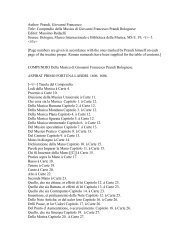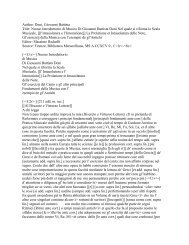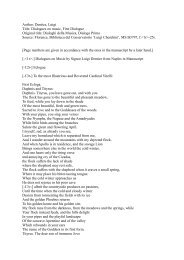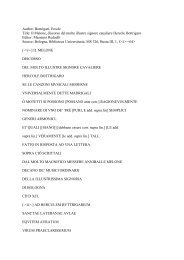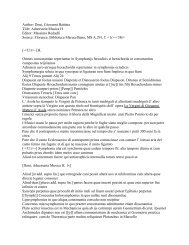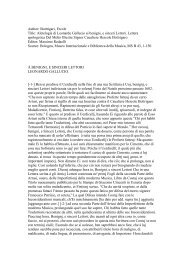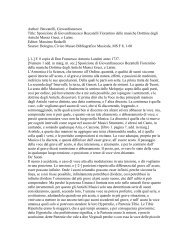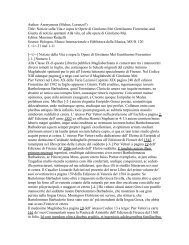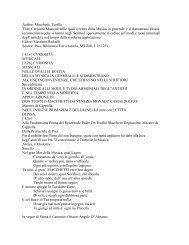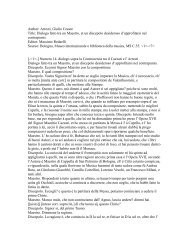Author: Doni, Giovanni Battista - manuscripts of italian music theory ...
Author: Doni, Giovanni Battista - manuscripts of italian music theory ...
Author: Doni, Giovanni Battista - manuscripts of italian music theory ...
You also want an ePaper? Increase the reach of your titles
YUMPU automatically turns print PDFs into web optimized ePapers that Google loves.
Therefore, to express more fully the character <strong>of</strong> Enharmonic Harmony, I would say<br />
tat it can be compared to the sort <strong>of</strong> wines which have a flavour which is both sweet<br />
and spicy, and that this does not correspond badly to those properties attributed to it<br />
by Aristides, namely to be [epion], namely, s<strong>of</strong>t and sweet, as well as [egertikon],<br />
namely energetic and effective in moving the emotions and awakening the<br />
imagination, just as one <strong>of</strong> these two flavours pleases and melts the palate, and the<br />
other one titillates, so to speak, the sense <strong>of</strong> taste, pleasingly twice in the process.<br />
Hence, it is clear that the Diatonic shall be like those wines that have only something<br />
<strong>of</strong> the brusque and the pleasant, while the Chromatic is judged universally as<br />
resembling sweet and suave wine. One might also say that the metaphor according to<br />
which some wines are called generous and grand, [--] such as the Greek wine<br />
which I believe was called Aminaeus by the ancients, corresponds equally to the<br />
Enharmonic Genus, to which that [semnon], or grand and magnificent manner, is<br />
ascribed. But, since the word austerus, in this particular matter <strong>of</strong> the wines, does not<br />
mean, according to the Greek Physicians and other good authors, that unripe and<br />
rustic flavour which can be tasted in certain small and new, as it is mostly believed,<br />
but rather, what it in Latin is called dry and appears to denote only a lack <strong>of</strong> sweetness<br />
and tenderness, I would say that, in this sense, it is better suited perhaps to the simple<br />
Enharmonic, while the sweet and spicy suits the mixture <strong>of</strong> the Diatonic and<br />
Chromatic, since a certain dryness, severe simplicity and a certain majestic grace as<br />
well is really suited to the Enharmonic, as it is the one that can see, moving from one<br />
comparison to the other, in the ancient paintings (as long as by good Masters) which<br />
have lost, because <strong>of</strong> time, that brightness <strong>of</strong> colours, hence we can also say that in<br />
painting as well the Diatonic resembles that colour which we say has something <strong>of</strong> the<br />
crude, while the Chromatic resembles the paintings made with florid colours or<br />
percolori floridi, as Pliny call them and the Greeks before him called [antherous].<br />
Those are understood to be the ones which are more brilliant and delightful such as<br />
the ultramarine among the blues and the Cinnabar called Dragon’s Blood among the<br />
reds, which, according to Pliny, were provided by those who commissioned the work<br />
at their expense, as it is the case still nowadays, and not by the Painter. The paintings<br />
that have beautiful colours are like the Chromatic melodies, while the ones which are<br />
composed <strong>of</strong> austere colours will resemble the Enharmonic ones, since austere were<br />
called the colours what are the opposite <strong>of</strong> the florid ones, which are not very brilliant<br />
and render the painting more mature and ancient, as in the case <strong>of</strong> .<br />
[--] Also, since Architecture has some affinity with painting and with<br />
Harmonics, we can also consider its five styles, which, in my opinion, are more<br />
similar to the Genera than to the Modes. They are the Tuscan, the Dorian, the Ionian,<br />
the Corinthian and the Roman or Composite. The Tuscan, the simplest <strong>of</strong> all, which<br />
was very unsophisticated and with few Canons, was compared very aptly to the<br />
common genus which produces the melody which is exactly the most simple. The<br />
Dorian matches the Enharmonic melody, since it has a certain simple gracefulness as<br />
that one. The Chromatic matches the Corinthian, which is more ornate than all the<br />
other simple genera and it has many different intervals just as that style has different<br />
Canons. However, it seems to me that the Diatonic resembles more closely the Ionic<br />
style, since it more suited better than the other ones to sad and cheerful moods and<br />
other contrary qualities, just as the relaxed order seems to be that it would be more<br />
suited than the others with its simple details and its added ornaments. Finally, the<br />
order which is called composite and Italic, which is better named Roman, since it was<br />
applied by the Romans, as the Tuscan in particular was no less Italic than that one,


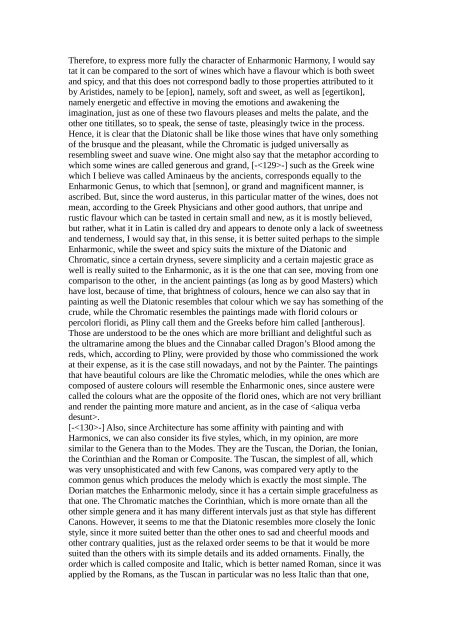
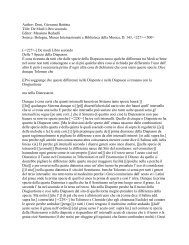
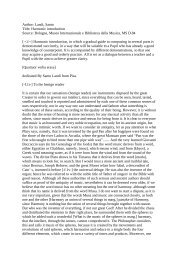
![Doni, Giovanni Battista Title: Trattato Dei Tuoni o [[Harmonie de]]](https://img.yumpu.com/45461005/1/190x245/doni-giovanni-battista-title-trattato-dei-tuoni-o-harmonie-de.jpg?quality=85)
